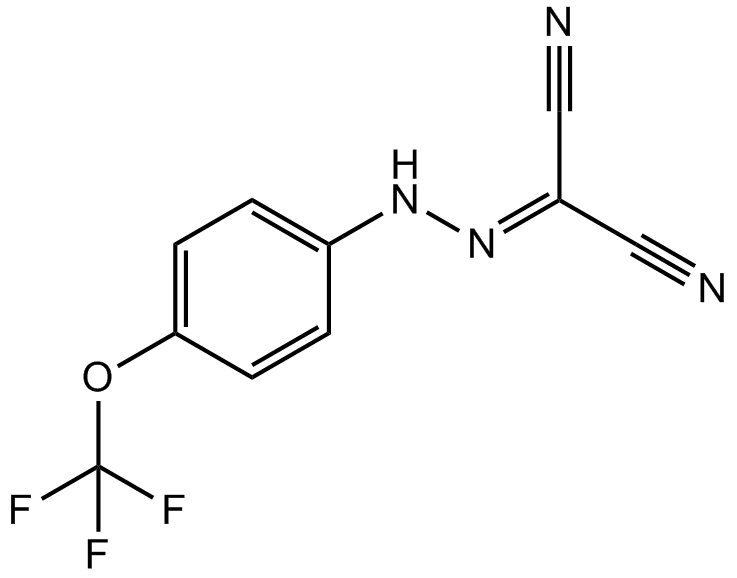FCCP (Synonyms: Trifluoromethoxy carbonylcyanide phenylhydrazone) |
| カタログ番号GC14328 |
FCCPは、プロトンキャリア(H+イオノフォア)であり、強力なリン酸拡散結合剤でもある。これは、細胞膜およびミトコンドリア膜の脱分極を促進する。
Products are for research use only. Not for human use. We do not sell to patients.

Cas No.: 370-86-5
Sample solution is provided at 25 µL, 10mM.
FCCP, a proton carrier (H+ ionophore), is also a powerful phosphoric acid defusing coupling agent, which promotes the depolarization of plasma membrane and mitochondrial membrane.FCCP can affect various activities in which cellular calcium ions participate, inhibit K+ background current and induce small inward current, decrease 0.1 unit pH, and induce intracellular Na+ to increase. FCCP can stimulate Mg2+-ATPase activity, inhibit β-amyloid formation, and simulate the physiological effect of glutamate receptor agonist NMDA on mitochondrial superoxide.
Exposure of K695sw cells to the protonophore FCCP resulted in a concentration-dependent decrease in both Aβ release and the formation of the cell-associated C99 fragment. Production of the ectodomain fragment APPsα was only affected by exposure to the highest concentration of FCCP, whereas neither total cellular levels of APP nor the maturation of APP via N /O -linked glycosylation appeared to be affected by any concentration of FCCP used[1]. Pre-exposure to 200 nM FCCP during 120 min protects and enhances the follicle integrity in cat ovarian tissue during short-term in vitro culture[2]. Concentrations of FCCP that cause mitochondrial oxidation without depolarisation are cardioprotective. Higher FCCP concentrations dissipate mitochondrial membrane potential and exacerbate injury[3]. FCCP activated ionic currents and depolarized the plasma membrane potential in a dose-dependent manner. Neither the removal of extracellular Ca2+ nor pretreatment with BAPTA/AM affected the FCCP-induced currents, implying that the currents are not associated with the FCCP-induced intracellular [Ca2+]i increase[4]. Application of FCCP evoked a gradual increase in cell body [Ca2+]i that reached a level approximately 3-fold higher than baseline after 60 min. Moreover, FCCP released Ca2+ even when added after mitochondrial stores of Ca2+ had previously been emptied by an alternate method. FCCP, in addition to its recognized effect on mitochondrial Ca2+ sequestration, also releases Ca2+ from a non-mitochondrial store and is, therefore, unsuitable for use in an intact neuron to selectively inactivate mitochondrial Ca2+ uptake[5]. A further analysis of this effect on BHK21 cells has shown that a decrease in the number of microtubules can be observed 15 min after adding FCCP and there is complete disruption after 60 min. Regrowth of microtubules was initiated 30 min after removal of FCCP, in marked contrast with the rapid reversion observed when microtubules are disrupted by nocodazole[6].
References:
[1]. Connop BP, Thies RL, et,al. Novel effects of FCCP [carbonyl cyanide p-(trifluoromethoxy)phenylhydrazone] on amyloid precursor protein processing. J Neurochem. 1999 Apr;72(4):1457-65. doi: 10.1046/j.1471-4159.1999.721457.x. PMID: 10098849.
[2]. Tanpradit N, Chatdarong K, et,al. Carbonyl cyanide 4-(trifluoromethoxy)phenylhydrazone (FCCP) pre-exposure ensures follicle integrity during in vitro culture of ovarian tissue but not during cryopreservation in the domestic cat model. J Assist Reprod Genet. 2016 Dec;33(12):1621-1631. doi: 10.1007/s10815-016-0810-5. Epub 2016 Sep 17. PMID: 27639998; PMCID: PMC5171893.
[3]. Brennan JP, Berry RG, et,al. FCCP is cardioprotective at concentrations that cause mitochondrial oxidation without detectable depolarisation. Cardiovasc Res. 2006 Nov 1;72(2):322-30. doi: 10.1016/j.cardiores.2006.08.006. Epub 2006 Aug 16. PMID: 16979603.
[4]. Park KS, Jo I, et,al. FCCP depolarizes plasma membrane potential by activating proton and Na+ currents in bovine aortic endothelial cells. Pflugers Arch. 2002 Jan;443(3):344-52. doi: 10.1007/s004240100703. Epub 2001 Oct 6. PMID: 11810202.
[5]. Jensen JR, Rehder V. FCCP releases Ca2+ from a non-mitochondrial store in an identified Helisoma neuron. Brain Res. 1991 Jun 14;551(1-2):311-4. doi: 10.1016/0006-8993(91)90947-t. PMID: 1913158.
[6]. Maro B, Marty MC, et,al. In vivo and in vitro effects of the mitochondrial uncoupler FCCP on microtubules. EMBO J. 1982;1(11):1347-52. doi: 10.1002/j.1460-2075.1982.tb01321.x. PMID: 6765194; PMCID: PMC553215.
Average Rating: 5 (Based on Reviews and 11 reference(s) in Google Scholar.)
GLPBIO products are for RESEARCH USE ONLY. Please make sure your review or question is research based.
Required fields are marked with *




















